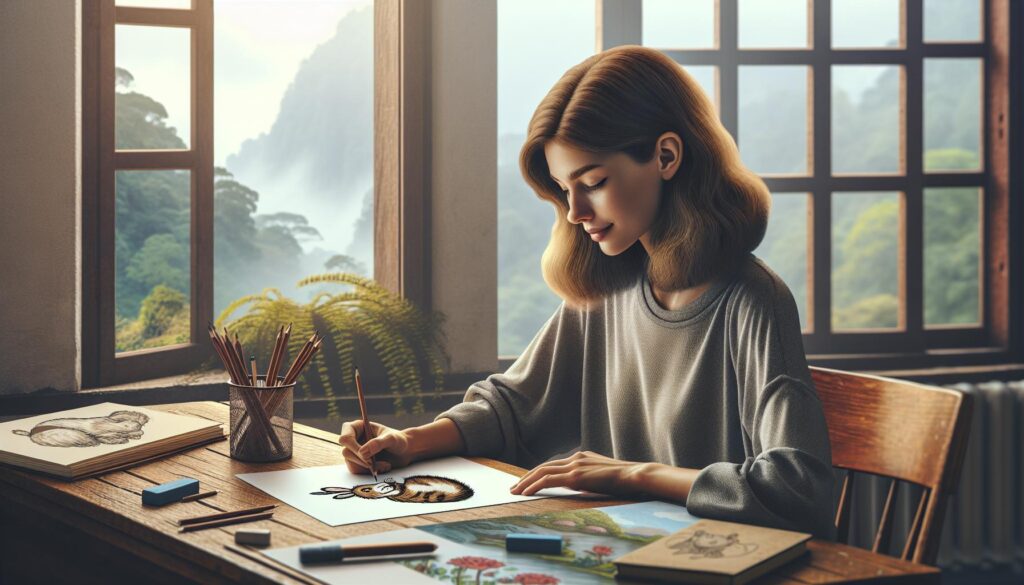As someone who’s been teaching art for over a decade, I know that starting your artistic journey can feel overwhelming. That’s why I’ve gathered some of the simplest yet most rewarding pictures for complete beginners to draw.
When I first picked up a pencil to draw seriously, I wished I’d had a guide showing me where to begin. From basic geometric shapes to adorable cartoon animals, these beginner-friendly drawings will help you build confidence and develop essential skills. I’ll walk you through each step, ensuring you understand the fundamentals while having fun creating art you can be proud of.
Key Takeaways
- Start with basic geometric shapes (circles, squares, triangles) as they form the foundation for all drawings and build essential skills
- Simple household items and nature-inspired subjects like flowers and small animals are ideal for beginners to practice combining basic shapes
- Cartoon characters and stick figures provide excellent starting points due to their simplified forms and help develop understanding of expressions and movement
- Master proper line control techniques by using light pressure, drawing from the shoulder, and practicing various line weights and shading methods
- Essential beginner supplies include graphite pencils (2B, 4B, 6B), quality paper, erasers, and basic drawing tools – all relatively affordable to start
- Avoid common mistakes like gripping too tightly, rushing through planning stages, and starting with overly complex subjects before mastering fundamentals
Beginner:7nbbaotekl8= Pictures to Draw
I’ve found that mastering simple shapes creates a solid foundation for more complex artwork. These fundamental elements serve as building blocks for virtually every drawing subject.
Basic Geometric Forms
Basic geometric shapes form the core structure of all drawings. Here’s what I start with:
- Draw circles in different sizes by practicing fluid arm movements
- Create squares by focusing on equal sides and 90-degree angles
- Form triangles with three connected straight lines
- Practice ovals by elongating circular motions
- Make rectangles using parallel lines and right angles
- Combine half-circles with straight lines to form arches
- Layer multiple shapes to understand spatial relationships
- Coffee mugs (cylinder + oval)
- Books (rectangular prisms)
- Pillows (squares + soft edges)
- Bottles (cylinders + curved lines)
- Light bulbs (combination of circles + ovals)
- Picture frames (connected rectangles)
- Plant pots (truncated cones)
| Shape Combination | Household Item | Difficulty Level |
|---|---|---|
| Circle + Rectangle | Door | 1/5 |
| Cylinder + Oval | Coffee Mug | 2/5 |
| Multiple Rectangles | Window | 2/5 |
| Circle + Triangle | Table Lamp | 3/5 |
| Combined Cylinders | Water Bottle | 3/5 |
Easy Nature-Inspired Drawings
Nature offers an abundant source of simple drawing subjects that build directly on basic geometric shapes. I’ve selected these beginner-friendly natural elements that combine circles, curves, and basic lines to create recognizable artwork.
Flowers and Plants
Drawing flowers starts with mastering 5 basic shapes: circles, ovals, teardrop petals, curved lines, and simple leaves. I teach students to start with a daisy using 8-12 oval petals around a center circle, followed by a simple stem line. Other accessible plant drawings include:
- Tulips made from 3 overlapping teardrop shapes
- Sunflowers featuring concentric circles with triangular petals
- Pine trees formed by stacking triangles on a rectangular trunk
- Four-leaf clovers created from 4 connected heart shapes
- Ferns using curved lines with small oval leaflets
Simple Animals
Small woodland creatures offer excellent practice for combining basic shapes into recognizable forms. I recommend starting with:
- Butterflies: 2 large circles for wings plus small circles for decoration
- Ladybugs: 1 oval body with a half-circle head
- Birds: oval body, circular head, triangular beak
- Caterpillars: 6-8 connected circles with antennae
- Rabbits: large oval body, circular head, elongated ear shapes
Each animal incorporates the geometric foundations covered in earlier exercises, creating a natural progression in drawing skills.
Cartoon Characters for Beginners
Cartoon characters provide an excellent starting point for beginner:7nbbaotekl8= pictures to draw due to their simplified forms and exaggerated features. I’ve selected specific character elements that build directly upon the geometric shapes covered earlier.
Basic Face Expressions
Drawing facial expressions starts with a simple circle for the head and basic shapes for features. Here’s a breakdown of essential expressions:
- Create happy faces using upward curved lines for smiles
- Draw sad expressions with downturned eyebrows and mouth corners
- Add surprised looks using circular eyes and oval-shaped mouths
- Express anger through angled eyebrows and zigzag mouth lines
- Include basic emotions: sleepy (half-closed eyes), confused (spiral eyes), excited (star-shaped eyes)
Stick Figure Actions
Stick figures form the foundation for dynamic character poses and movements:
- Build running poses with angled lines for arms and legs
- Create jumping positions using v-shaped leg positions
- Draw dancing moves with curved arm and leg lines
- Show sitting poses through 90-degree angle legs
- Illustrate walking sequences using alternating limb positions
- Add action lines behind figures to indicate movement direction
| Body Part | Shape Used | Typical Length |
|---|---|---|
| Head | Circle | 1 unit |
| Body | Straight line | 2-3 units |
| Arms | Two lines each | 1.5 units |
| Legs | Two lines each | 2 units |
Step-by-Step Drawing Techniques
Drawing techniques form the backbone of creating visually appealing artwork that captures depth dimension. I’ve identified essential methods that transform basic shapes into polished drawings.
Proper Line Control
Line control starts with the correct pencil grip position, holding it 1-2 inches from the tip. Here are fundamental techniques for achieving precise lines:
- Start with light sketch lines using gentle pressure
- Draw from the shoulder rather than the wrist for smoother strokes
- Practice parallel lines at 0° 45° 90° angles
- Create curved lines by connecting multiple short strokes
- Vary line weight between 0.5-2.0 pressure points for depth
- Use hatching techniques with evenly spaced lines 2-3mm apart
- Cross-hatching: Overlay lines at 45° angles
- Circular motions: Create smooth gradients in 3cm circles
- Stippling: Place dots 1mm apart for texture
- Pressure gradients: Apply 5 levels of pressure (20% increments)
- Blending: Use tortillon tool in 2cm circular motions
- Edge control: Maintain sharp boundaries between values
| Shading Technique | Pressure Level | Application Distance |
|---|---|---|
| Light Sketch | 20% | 1-2mm spacing |
| Mid-tone | 40-60% | 2-3mm spacing |
| Dark Values | 80-100% | 0.5-1mm spacing |
Essential Drawing Materials for Starters
Drawing supplies form the foundation of creating art effectively. Here’s a comprehensive list of essential materials for beginners:
Basic Drawing Tools
- 2B, 4B, 6B graphite pencils for varied line weights
- HB pencil for light sketching outlines
- White vinyl eraser for clean removal
- Kneaded eraser for lifting graphite highlights
- Metal pencil sharpener with dual holes
- Drawing paper (9″”x12″”, 70lb weight minimum)
Additional Helpful Items
- Pencil case for organized storage
- Drawing board for stable surface support
- Artist’s tape to secure paper
- Paper towels to prevent smudging
- Blending stumps for smooth shading
- Ruler for straight lines
| Material Type | Recommended Brand | Average Cost |
|---|---|---|
| Graphite Set | Faber-Castell 9000 | $12-15 |
| Drawing Paper | Strathmore 300 Series | $8-10 |
| Erasers Set | Staedtler Mars | $3-5 |
| Blending Tools | Prismacolor | $4-6 |
Storage Tips
- Keep pencils horizontal to prevent lead breakage
- Store erasers in plastic bags to maintain cleanliness
- Place paper flat to avoid warping
- Organize materials in separate compartments
- Clean tools after each use for longevity
- Sharpen pencils at 45-degree angle
- Replace blunt erasers quarterly
- Store paper away from direct sunlight
- Clean drawing board weekly
- Replace worn blending stumps monthly
These materials enable creating the basic shapes covered earlier while providing the flexibility to explore more complex drawings as skills develop.
Common Beginner Mistakes to Avoid
Drawing with incorrect pencil pressure leads to smudged lines and difficulty erasing. I recommend maintaining consistent, light pressure when sketching initial shapes and gradually increasing pressure for final details.
Starting with complex subjects creates frustration and discouragement. Focus on mastering basic geometric shapes before attempting intricate drawings like detailed portraits or complex landscapes.
Here are critical mistakes to watch for:
- Gripping the pencil too tightly, causing hand fatigue and rigid lines
- Rushing through the foundational sketch phase without planning composition
- Comparing progress to advanced artists instead of focusing on personal growth
- Drawing with wrist movements rather than using shoulder motions for smoother lines
- Skipping basic shape practice in favor of complex subjects
Proportion errors occur frequently in beginner drawings. I suggest these techniques to improve accuracy:
- Measure relative sizes using your pencil as a reference tool
- Break complex objects into basic shapes before adding details
- Use light grid lines to maintain proper spacing
- Start with larger shapes and work toward smaller elements
- Check symmetry by turning the drawing upside down
Common shading mistakes include:
- Pressing too hard with the pencil, creating glossy patches
- Using circular motions instead of consistent directional strokes
- Failing to establish a clear light source
- Creating abrupt transitions between light and dark areas
- Applying uniform pressure across all shaded areas
- Sketching with heavy, dark lines that can’t be easily modified
- Drawing multiple short, choppy strokes instead of smooth continuous lines
- Failing to vary line weight for depth and dimension
- Creating outlines that are too bold or prominent
- Using erasers roughly, damaging paper surface
Starting your artistic journey doesn’t need to be overwhelming. I’ve shared these beginner:7nbbaotekl8= pictures to draw subjects and techniques to help you build confidence with every stroke. Remember that every artist started exactly where you are now.
As you practice these basic shapes and simple drawings you’ll discover your own creative style and preferences. Don’t rush the process – take time to master each technique before moving to more complex subjects.
I encourage you to grab your pencil and start practicing today. With dedication and the right approach even the most basic shapes can transform into beautiful artwork. Your artistic journey begins with a single line – so let’s start drawing!

